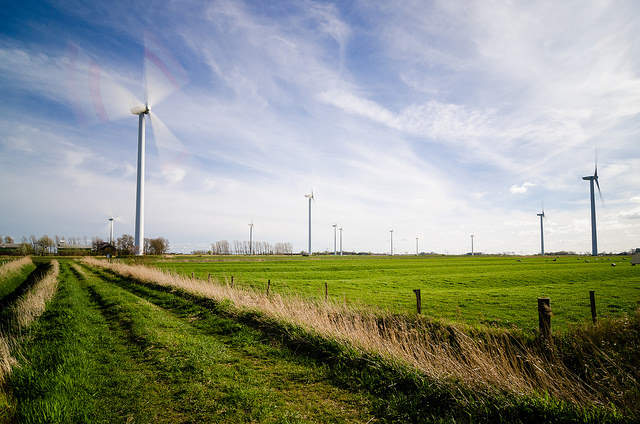
The new year will mark a new beginning of sustainable operations for the Dutch airports under the Royal Schiphol Group. From 1 January 2018, Amsterdam Schiphol, Rotterdam The Hague, Eindhoven and Lelystad airports will start drawing all their energy needs from newly built wind farms in the country.
Under the deal, Eneco will supply approximately 200GWh of renewable energy to the airports, equivalent to the electricity requirements of 60,000 households in the country.
Airports are notoriously power-intensive investments, both during construction and for day-to-day operations. Solar power is the preferred sustainable power source of airports worldwide, while wind power has so far not been as popular.
However, the initiative gained praise not only for the airports’ commitment to transition to green energy, but also for ensuring the power they use is generated within the Netherlands. The 15-year deal means that, instead of drawing power from the existing grid, Schiphol Group will instead contribute to the proliferation of wind farms in the Netherlands.
“Our primary focus is our ambition to be carbon-neutral by 2040,” says Royal Schiphol Group spokesperson Hans van Kastel. “And the switch to a 100% sustainable wind power source is a next step to realise that ambition.”
Building new wind energy sources
Outside of aviation, wind power is steadily growing in popularity. Last year, it was the largest destination for power sector investments, according to WindEurope. During the first quarter of 2017, €1.8bn was invested in Europe in new projects, projects under construction and those in operation.
How well do you really know your competitors?
Access the most comprehensive Company Profiles on the market, powered by GlobalData. Save hours of research. Gain competitive edge.

Thank you!
Your download email will arrive shortly
Not ready to buy yet? Download a free sample
We are confident about the unique quality of our Company Profiles. However, we want you to make the most beneficial decision for your business, so we offer a free sample that you can download by submitting the below form
By GlobalDataWind energy is expected to become Europe’s largest renewable source by 2020, with three quarters of installations in the next four years to concentrate in just six countries: Germany, the UK, France, Spain, the Netherlands and Belgium.
The first facility to supply power to the airports will be Vianen wind farm in January 2018, followed by a host of newly-constructed farms from 2020 onwards.
The four airports selected for the transition handle almost all civil aviation flights arriving in or departing from the Netherlands, and transported 70 million passengers and almost 1.7 million tonnes of cargo in 2016.
“We didn’t need to make any adjustments,” van Kastel says. “What it took [on our part] was to set up a new contract with a new supplier. Our main condition during the tender was that the all the power we need must be raised in the Netherlands and Eneco guaranteed this.”
Although the shift to renewable energy will prove to be a bit more costly compared to traditional sources, van Kastel says the price wasn’t a particular concern. Instead, Schiphol seems to be driven by the belief that aviation can and must be made more sustainable.
“To be honest, the biggest challenge is for our partner Eneco,” van Kastel says. “According to the contract we agreed on, they need to build new windmills to supply us with the power we need.”
“This shows that we as an airport can deliver a major contribution in adding more sustainable power sources. And yes, we do believe that other airports can achieve the same.”
Playing a role in carbon neutrality
The four selected Dutch airports, however, won’t be the first fully sustainable airports in the world.
That title belongs to Galapagos Ecological Airport, opened in 2012, which takes 100% of its energy from a combination of a solar panel array and a wind farm. Since then, India’s Cochin International Airport has become the world’s first airport to run solely on solar power, followed by George Airport in South Africa. Indeed, when it comes power generation, the undisputable future lies in solar, with over 100 airports worldwide currently hosting photovoltaic panels on their grounds.
But while switching to renewable sources could prove to be tricky for some, reducing energy consumption at airports is a first step.
This was the main aim of European project CASCADE, where nine partners from four European countries enacted pilot projects to test new software, algorithms for fault detection and diagnostics to devise a better energy action plan and make reductions wherever possible. The project found that typically, the daily electricity and thermal energy used by a large airport compares to that of a city of 100,000 people.
As part of the trials, which concluded in 2015, Rome’s Fiumicino and Milan’s Malpensa airports cut their heating, ventilation and air conditioning systems by 20% to reduce their overall consumption.
Through its most recent agreement, Schiphol has proved that airports can not only clean up their act, but also go above and beyond, contributing to the creation of future sustainable energy sources for years to come. Initiatives such as these play an important role in advancing ACI Europe’s ambition to have 50 carbon-neutral airports by 2030.







